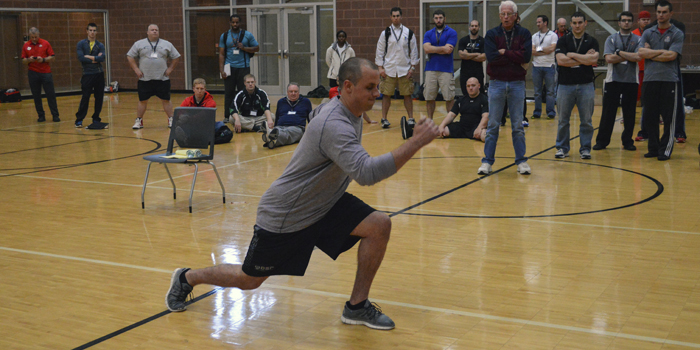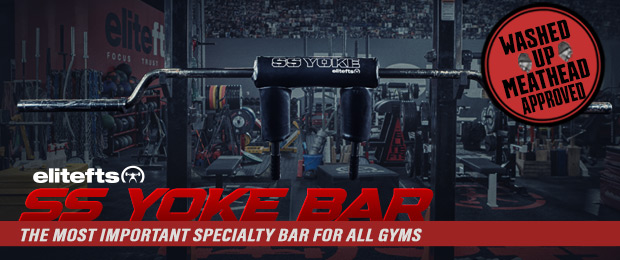
Single-leg exercises are not often viewed as primary movements in most athletes’ training programs. Instead, these exercises are shuffled toward the back of the program with the other accessory movements. And to make matters worse, athletes tend to go through the motions when performing them.
However, we know that athletes especially need to prioritize single-leg training and excel at these movements. To do this, we as coaches must prioritize single-leg training and deem it essential in our programs. These exercises can easily be used in the three key training methods: the maximal effort method, dynamic effort method, and repetition effort method.
Single-leg training can benefit athletes in the following ways:
- Correcting muscular imbalances and strengthening weak points in the lower body.
- Enhancing durability and injury reduction.
- Improving proprioception and balance.
- Enhancing the stability of the hip and trunk muscles.
- Has a high transferability to many athletic movements such as sprinting, jumping, and cutting for change of direction speed.
As always, context is key, and you need to find what is most appropriate for your athletes. There should be a solid foundation of bilateral strength in the lower body from squatting and hinging movements before you start to load or train unilateral exercises. If an athlete cannot perform a proper goblet or bodyweight squat, then kicking a leg back into a split squat or lunge will probably create even more problems.
RECENT: The Bar You're Not Using But Should Be
Single-Leg Training with the Maximal Effort Method
Utilizing single-leg exercises with the maximal effort method seems to be the most concerning when discussing this with other coaches and colleagues. And rightfully so; when training a single-leg exercise, balance will be challenged, so the capability to produce maximum muscle force is immediately lessened.
While athletes can still perform unsupported, standard single-leg movements such as lunges, step-ups, and split squats with maximum effort–and I do believe that can have a place in a program–if you want maximum load and effort, it won't match what is seen in bilateral exercises without offering some support.
Selecting supported exercises will create the best of both worlds. We’re still loading the single leg, and these exercises are executed in a way that is safe and effective.
Some exercises I recommend using in the maximal effort method include.
Supported Safety Squat Bar (SSB) Split Squat
YouTube
Supported SSB Reverse Lunge
YouTube
Supported SSB Rear Foot Elevated Split Squat
YouTube
The supported exercises work great. All you need is a Safety Squat Bar to set your rack up appropriately. When performing the exercises, the support is used to provide stability throughout the exercise; the athletes shouldn't be relying solely on the handles to complete the lift.
A second option when performing single-leg exercises with the maximal effort method is performing concentric-only exercises or movements performed from a dead-stop position.
Examples of this could be performing exercises from pins or the ground.
Dead-Stop Bulgarian Split Squat
YouTube
The dead-stop Bulgarian split squat is essentially a single-leg deadlift and one of the least favorite exercises I have ever programmed for my athletes. It is universally difficult and requires tremendous strength from a single-leg position. While athletes may despise it, its benefits are clear, and some love the challenge.
When performing these exercises, I recommend performing them anywhere between 1-3 reps per side in a single set. It is important to allow for complete rest in between sets to ensure the quality of movement.
I have used all these exercises with my athletes and have had great results while keeping them safe and loading unilateral exercises to the limit. Many athletes even surprise themselves at what they can lift just off one leg.
Single-Leg Training with the Dynamic Effort Method
Almost every athletic movement we see in the field of play comes from a single-leg position, whether it be sprinting, cutting, jumping, landing, falling, etc. There is a point where our athletes are in a single-leg position and expected to be as capable and explosive as possible.
This is all the reasoning you need to begin incorporating single-leg exercises into the dynamic effort method for your athletes.
Exercises such as jumps, bounds, and hops help fit these needs and can be performed through multiple planes of movement, such as linear, lateral, and even rotational.
Single-Leg Box Jump
YouTube
Single-Leg Broad Jump
YouTube
Single Leg Bounds
YouTube
YouTube
Rearfoot Elevated Split Jumps
Split Jumps
YouTube
The variations are endless. These exercises can be performed in every direction imaginable and can be adjusted by landing on a single or double leg to meet the needs and abilities of your athletes.
Also, using Verkoshansky’s dynamic correspondence model, we know that the direction and speed of an exercise are what make an exercise “specific.”
Using jumps allows those speeds to be met better than barbell-based exercises, and they can also be used in specific planes of direction to meet the demands of the athlete.
An example would be prescribing a basketball or volleyball athlete more lateral-based bounds and jumps compared to an experienced track athlete.
The best sport-specific exercise will always be the sport itself, but incorporating exercise with this mindset will better allow us to physically prepare our athletes and create more trust and support.
Performing single-leg exercises in the typical dynamic effort speed model is also an effective option. Placing accommodating resistance on exercises such as step-ups, lunges, or split squats can be performed with great success and allow the athlete to demonstrate higher speed qualities of strength on a single leg.
Barbell Reverse Lunge versus Accommodating Resistance
YouTube
Attaching a few chains or light bands while performing this exercise is a complete game-changer. Unloading the resistance in the bottom position will allow athletes to explode back to the starting position of the single leg.
Banded Dumbbell Step-Ups
YouTube
This exercise requires a little space, but attaching a couple of resistance bands before anchoring one side to a sturdy point will allow you to perform explosive dumbbell step-ups.
Once the bands are set up, the athlete can step into the opposite loop of the band and walk away to gather resistance before performing the dumbbell step-up violently through a bench or box.
Supported SSB Bulgarian Split Squat Versus Accommodating Resistance
YouTube
It’s the same setup and exercise selection from the maximal effort section. Still, we use it to focus on bar speed instead of maximal load. Honestly, this may be even more difficult than the maximal effort due to the over-speed eccentrics of the bands or instability that the chains create.
These exercises can all be rotated with different types and amounts of accommodating resistance.
Single-Leg Training with The Repetition Effort Method
The repetition effort method can bring up muscular imbalances and weak points on the less dominant or “weaker” leg. We place this toward the end of the session with the accessory movements and focus on higher rep ranges and different motives.
When attempting to stress the single-leg training with higher reps and increasing the time under tension, using single-joint, machine-based exercises will be ideal—maintaining the objective of strengthening the muscle without the pressures of worrying about falling over. Some of these exercises include.
Single-Leg Leg Extensions
Single-Leg Leg Curls (Seated or Lying)
YouTube
I recommend using more stability-based or unsupported exercises with this method as well. Focusing on exercises stressing more balance and proprioception to complete a well-rounded single-leg development program. Some of those exercises include.
Single-Leg RDLs (Landmine)
YouTube
The single-leg RDL is the primary single-leg hinging exercise option. It can be performed with multiple implements, like dumbbells, kettlebells, or barbell options like the landmine.
Deficit Reverse Lunge
YouTube
Adding a deficit to a movement like the reverse lunge is great to challenge the athlete with an increased range to overcome but doesn’t require more load. So, working exercises like this in-season are a great bang for your buck movement, working on increasing mobility and maintaining strength.
Single-Leg Box Squats
YouTube
Performing box squats with a single leg uses the same approach as a regular box squat. Have control on the way down, sit back on the box as if it were a glass table, and explode off the box to the starting position.
Skater Squats
YouTube
If athletes can easily knock out the single-leg box squat, it may be time to remove the box. I prefer moving to the skater squat next since the front load will create a counterbalance for the athlete and is usually far more successful than jumping right into a pistol squat.
Step Downs
YouTube
Step downs are single-leg squats that you perform off of a box. The step-down is a great exercise for ankle and knee health, along with single-leg strength. Many athletes struggle with this exercise and cannot complete it while keeping their heel flat on the box. If this is the case, performing off a smaller box at a restricted range of motion is best.
Lateral Squats & Lunges
YouTube
YouTube
Athletes must include some frontal plane-based exercises in their program. They are necessary since most sports are performed in all planes and help build durability and strength in the adductor muscles.
Single-Leg Glute Bridge
YouTube
This is a great exercise option because it requires no equipment, and it is surprisingly tricky if the athlete performs the exercise controlled with the correct intent of squeezing their glutes at the top as if their life depended upon it.
Don’t Leave Single-Leg Movements Out Of Your Program
Single-leg exercises must be prioritized in our athlete's training programs. Use them in your minimal, dynamic, and repetition effort methods, and your athletes will be challenged in ways they’ve never felt before. Guaranteed.

Brandon Holder, B.S, CSCS, is the strength and conditioning coordinator of the Fairfax County Police Department. He has diverse coaching experiences working in the private sector and stops in the collegiate setting. Working with everyone from elite athletes, youth athletes, tactical athletes, and everyday individuals. Along with his coaching experience, he has previously competed in powerlifting and strongman competitions and holds certifications through US Weightlifting and US Track & Field, amongst others.











Nicely structured , well explained !!!